Brand personalization is all about making EVERY customer feel like they are the star of a show and not just another customer.
It may sound daunting and even impractical to scale this.
But it is possible to customize brand experiences as per the needs and preferences of customers by following the principles of personalized marketing.
A study by Infosys found that:
- 86% of consumers acknowledged the contribution of personalization to their purchase decisions.
- 25% firmly believed that personalization significantly affects their purchase decision.
The best part about personalized marketing is that – you don’t need to spend thousands of dollars on AI marketing tools.
By involving your audience in the marketing process, companies can not only talk to their leads personally but also gather highly-relevant data for future marketing purposes.
Let’s take a short example:
Luxury car companies can deliver personalized experiences through Golf courses where most of their wealthy audience typically hang out.
Golf courses give them an opportunity to:
- Figure out what their target audience doesn’t like about the current solution.
- How they prefer to consume information.
- Extract brand personalization strategies from this exercise
These insights will help them personalize their experiences which, in turn, help generate a preference for their brand among their audience.
4 steps to personalize a brand and secure customer loyalty
Mass marketing doesn’t make a distinction between individual customers. The whole marketing strategy hinges on what are the traits of customer segments.
And most brands do this!
Brand personalization involves collecting and analyzing the data and extract insights that help create a unique experience for each individual.
They help hyperfocus your marketing strategy on customers and transform the mass marketing approach into a “one-on-one marketing strategy”.
And because you are doing things differently than most brands, there’s a huge competitive advantage in personalizing the marketing strategy.
Let’s look at some basic steps to create this one-on-one marketing strategy:
This opens the door to more data that you can use for personalized website experiences.
ASOS.com does it brilliantly on their sign up screen where, in addition to showing options for social sign up, they market this option with a little bit of extra text – to communicate the benefits of social login.
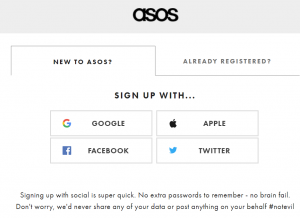
2. Remember customers preferences
If the product is not available in their size, show them this message the first time – so they don’t get disappointed after selecting it for purchase.
Derive other such preferences by locating patterns of usage in detailed attributes of the already-ordered products
3. Let them customize your products
Customers may have to compromise on the design and style of the products when they don’t find something that exactly matches their personal tastes.
Remove this uncertainty and let them design their own products.
We have seen Nike implement this personalized marketing strategy.
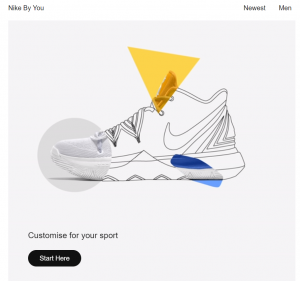
If you don’t have the resources for this, create a separate section on your customer screen that lets people share their preferences and personalize product recommendations accordingly. Invite your customers to fill in this section in exchange for a reward.
Exact matches may not be possible, but take inspiration from Netflix. It shows a numerical percentage of how close a title is to a viewer’s personal tastes.
If I watched an action movie on Netflix, I will start getting recommendations for similar action movies – each of them with a match percentage of 80% and above displayed right above the episodes list. Likewise, the suggestions for romantic comedies on Netflix will drop to the relevance of 60% and below.
Based on what you gather about the user through a detailed preferences survey, you can create a personalization engine on your website.
From start to finish, the customer is interacting with an entire ecosystem of non-homogenous touchpoints. Sharing data among these touchpoints integrates them into a single coherent experience.
Thus, the customer doesn’t have to bother about keeping each touchpoint informed of their movements.
The example in this image demonstrates the cross-touch-point collaboration perfectly.
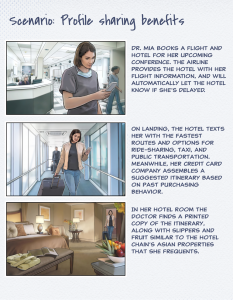
(Source: McKinsey.com)
4 reasons why Personalization is important
All purchases have an emotional reason (the problem that’s bothering your prospect) behind it. The reasons they give may seem logical but behind that logic, there is a painful emotion that has driven them to seek out a solution.
Without personalization, brands can’t help customers realize how pressing it is for them to resolve this painful emotion.
1. People (prospects, leads, and customers) expect it
Customers have gotten so used to getting personalized recommendations that they have come to expect it at every stage of their customer journey.

Source: Accenture Pulse Survey
A Salesforce Research survey of 7,000 business and consumer brands concluded that over half the customers are willing to share personal data in exchange of:
- personalized offers and discounts (57%)
- personalized recommendations (52%)
- personalized shopping experiences (53%)
Another study by Marketing Dive found out that if an unknown brand’s ad is personalized, consumers are 2x as likely to click it.
All this evidence points to one fact:
All brands – B2B or B2C, small, medium, or large – must actively engage their marketers to come up with brand personalization strategies.
2. Personalization helps generate trust with your leads
According to Salesforce Research, 90% of companies will only buy from companies they trust.
Simply put, if your sales process and agents don’t personalize their approach, it’s hard to gain the trust of your prospective customer.
And without trust, your sales department can’t tap into word-of-mouth marketing and referrals.
Brands must use personalization to generate trust in your prospects’ minds and encourage them to become your brand advocates.
3. Personalization is equally important for B2B brands
Just because B2B buyers are not buying for themselves does not mean they forget that they’re humans – and neither should marketers who target them.
A decision-maker (or a panel of multiple decision-makers) will still respond positively or negatively to personalized marketing.
According to a Salesforce Research study, a whopping 84% of customers say that to win their business, it’s important to treat them like a person (and not just a number!)
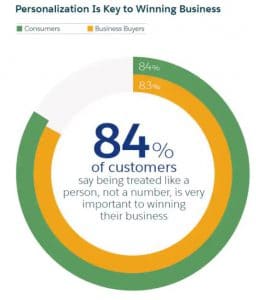
Source: Salesforce Research
The same study also shares more stats to back the need for personalization for B2B vendors up.
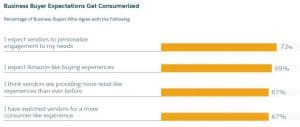
Source: Salesforce Research
4. Personalization leads to better return-on-investment (ROI) from marketing efforts
Personalization essentially means optimizing your marketing strategy to focus on:
- Finding and closing the highest-value leads
- Finding and leveraging the highest-converting channels
- Delivering highly optimized marketing messages
- Real-time communication
Having such a focused approach leads to more high-value leads becoming customers. It eventually generates more revenue and higher return-on-investment.for the B2B brands.
4 harmful types of over-personalization – How much is too much?
There is a fine line between meaningful personalization and being creepy.
Personalization, by definition, ALSO includes the time factor. If you send emails at night when the leads might be sleeping, or send the same message repeatedly for several months, it gets annoying.
Not only people, but brands can become needy and annoy their customers if they don’t put checks and balances on their personalization strategy.
According to an InMoment study, a whopping 75% of consumers think most forms of personalization are “somewhat creepy”.
As a result of the creepiness of your brand personalization experience:
- 20% of customers will leave
- 22% of customers will start shopping around for an alternative solution
- 31% of customers will participate in negative word-of-mouth marketing
All of this directly or indirectly contributes to your company’s bottom line.
So, how does one decide how much personalization is too much?
Fortunately, McKinsey shares an indicative personalization formula.
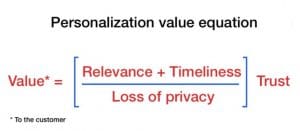
A personalization formula that covers different aspects of personalization and their relation to each other (Source: McKinsey.com)
This is more of a representation of the relationship between these factors and less of an actual mathematical equation.
The customer derives value from the level of relevance of the content and how well-timed is their experience.
And if they trust your brand, the value multiplies that many times.
It’s the denominator of this equation that many brands tend to unknowingly (or carelessly) double-down on.
So, what changed?
The Facebook-Cambridge Analytica scandal has had the same effect on people’s concerns about data privacy as 9/11 had on global air travel security.
A fantastic study by Jebbit acknowledges the changing marketing landscape, the new expectations of customers in the face of it, and how brands can move forward by building transparency and trust.

Source: Jebbit.com
And that’s why it’s important to understand the different types of harmful personalization strategies that we advise brands not to use.
1. Aggressive personalization
Stop showing ads to a user who has unsubscribed from your list. A barrage of retargeting ads to an opted-out user will annoy them and push them away from your brand.
This happens when the user has not consented to receive personalized marketing messages from you.
Often, brands buy an email list or borrow it from some other brand (where the user agreed to give their email address). That kind of personalization will certainly draw ire from the users; your unsolicited emails will quickly erase the trust and ruin all the hard work your marketing team puts in to create those amazing emails.
3. Insensitive personalization
Certain types of information (for example, detailed history of a user’s health issues) coming from a brand the user has never heard about (and therefore has no trust over) is definitely creepy.
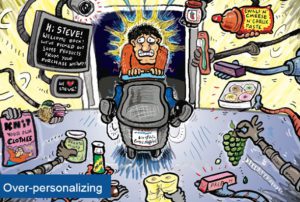
While customers also want to be understood well, they do NOT want to be spied on.
Such insensitive personalization will, in most cases, invite public backlash for the company and reduce the brand value for not just that one user, but everyone else in their immediate network.
4. Inaccurate personalization
If your customer data is not current, your brand runs the risk of inaccurate personalization.
Ensure that the data that empowers your brand personalization strategy is current and not outdated. Otherwise, your brand may lose its hard-earned positioning and trust among customers.
5 ways to use videos for B2B Sales Personalization
Personalized videos capture attention and help build trust by making it easy for customers to relate to your product.
With tools like Hippo Video, you can create template-based personalized video marketing campaigns with a few clicks. This enables you to leverage the power automation and target each of your contacts individually.
Here are 6 powerful use cases to leverage video personalization.
1. Send ABM campaigns with personalized videos, images, and text
You can save time by recording personalized demos and provide the same, consistent value to all the most important leads.
Then use these demos in emails or on landing pages.
2. Send hyper-personalized video email campaigns
Personalize every video with texts, logos, thumbnails, and more by creating video templates for use in mass email marketing.
You can also use mass video-marketing email campaigns for prospecting and webinar (or event) invites.
3. Create personalized sales pages instantly
A hyper-personalized sales page is a great way to engage with prospects and build instant trust with them. It breaks through any cluttered inbox of templated text emails.
By using a video carousel, you can attach video testimonials, product demos, or even after-sales documents on the same personalized sales page.
4. Accelerate your sales cycle
The traditional sales pipeline takes time because agents must go through a detailed intro call.
By creating personalized demo videos for anonymous prospects, sales agents:
- Move more leads to the buying stage quickly, thereby shortening the sales cycle.
- Get an idea of what the lead is looking for even before the first contact by using the analytics of these personalized videos.
- Get a higher-quality of qualified prospects
With such personalized sales videos, agents can easily convert activated demand into sales.
5. Reduce execution time for your sales contracts
Personalized images, texts, sales quotes, and calls-to-action – all these elements enable faster contract execution. With smart video sales contracts, your leads retain more of your sales message.
Better experience for leads translates into better customer relationships right from the start of the contract period.
3 ways to make extreme personalization work for your brand
In the retail/B2C arena, personalization isn’t as pervasive as it should be despite increasing demand for personalized engagement from the customers.
B2B brands can learn lessons from these B2C brands and extrapolate them into a solution for themselves.
Let’s look at some of those lessons as reported by ImpactBnd in their comprehensive infographic:
- 32% of brands cite lack of relevant technology makes personalization difficult for them. So, the retirement of legacy technology is the need of the hour.
- 46% of brands say that legacy technology greatly hinders their personalization efforts. The induction of relevant personalization technology can make the job easier.
- 35% of B2C marketers in the US reported that one of their biggest challenges was building a single, comprehensive customer view across sales and marketing channels. The addition of multi-channel capability for customer behavior analysis can help B2B brands usher in a new age of personalization for their prospects.
So, what is Extreme Personalization (EP) and how does it fit in this context?
EP prescribes personalization across context, content, and behavioral data. This means offering engagement:
- At the right moment of time
- On the right device
- With the right message
EP also includes a fully-integrated cross-channel experience.
Here are some modern marketing strategies fueled by extreme personalization:
1. Engage with an audience of one and understand individual preferences.
This requires a shift in how marketers think of segmentation i.e. move away from the batch-and-blast model of sharing marketing messages.
2. Use AI-based marketing automation tools to extract insights for cross-channel engagement.
3. Use AI-based marketing automation technology to A/B test variations based on extracted customer insights. This enables B2B marketers to stave off assumptions and implement data-based marketing strategies.
Concluding thoughts
Personalization is the need of the hour to improve customer experiences and business revenue. It provides universal value for all types of brands: B2B, B2B, large, medium-sized, or small!
But before brands embark on this seemingly profitable journey, there are pitfalls to know, understand, and avoid. The core principle is that people want brands to understand them, not spy on them.
B2B brands have numerous video personalization options to enhance their marketing and sales effort.
There’s no question about it: B2B brands must invest in the modernization of their sales process through personalized sales videos.

